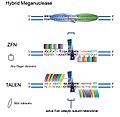Genome editing facts for kids
Genome editing is a super cool way to make changes to the DNA inside living things. Think of DNA as the instruction book for how an organism is built and how it works. Genome editing lets scientists carefully add, remove, or change specific parts of these instructions.
It uses special tools called nucleases, which are like tiny, super-precise "molecular scissors." These scissors can cut DNA at exact spots. Once the DNA is cut, the cell's own repair systems kick in. Scientists can then guide these repairs to make the changes they want, like fixing a broken instruction or adding a new one.
This technology is a big deal because it helps us understand how different parts of DNA (called genes) work. If a gene isn't working right, genome editing might be able to fix it.
Contents
How Genome Editing Works
Imagine your body's cells each have a huge instruction manual – that's your genome. This manual is made of DNA. Sometimes, there might be a typo or a missing page in this manual that causes problems.
Genome editing uses special "scissors" called nucleases. These aren't just any scissors; they are designed to recognize and cut DNA at a very specific spot. Once the DNA is cut, the cell tries to fix it. Scientists can use this natural repair process to:
- Remove a piece of DNA.
- Insert a new piece of DNA.
- Replace one piece of DNA with another.
This allows scientists to study what happens when a specific gene is changed or even to correct genetic mistakes.
Different Types of Molecular Scissors
For a long time, it was hard to make very specific changes to DNA. Scientists had to use indirect methods, like trying to "silence" a gene using something called RNA interference (siRNA). This was like trying to muffle a speaker so it couldn't be heard as well. But sometimes, it didn't work perfectly.
Then came engineered nucleases, like ZFNs. These were different because they could directly cut the DNA at a chosen spot. This was a huge step forward, allowing much more precise changes than before.
In 2011, the science journal Nature Methods even named genome editing the "Method of the Year" because of how important it was becoming.
The Amazing CRISPR/Cas9 System
One of the most exciting breakthroughs in genome editing is the CRISPR/Cas9 system. In 2017, it was celebrated as one of the biggest scientific achievements of the year!
Here's how it works simply:
- Cas9 is an enzyme (a type of protein that speeds up reactions) that acts like the cutting part of the molecular scissors.
- It works with a special "guide RNA" molecule. Think of this guide RNA as a GPS system that tells Cas9 exactly where to go on the DNA.
Once the guide RNA leads Cas9 to the right spot, Cas9 makes a precise cut. As Sir John Skehel, a famous scientist, explained, this system can allow scientists to:
- "Knock out" a particular gene, meaning they can turn it off or remove it.
- "Introduce" a particular gene, meaning they can add a new gene.
- "Correct" a gene that has a mistake, making it work better.
This technology is already being used in labs around the world to study diseases, develop new medicines, and even improve crops. It holds incredible promise for the future of science and health.
Images for kids
See also
 In Spanish: Edición de genoma para niños
In Spanish: Edición de genoma para niños






